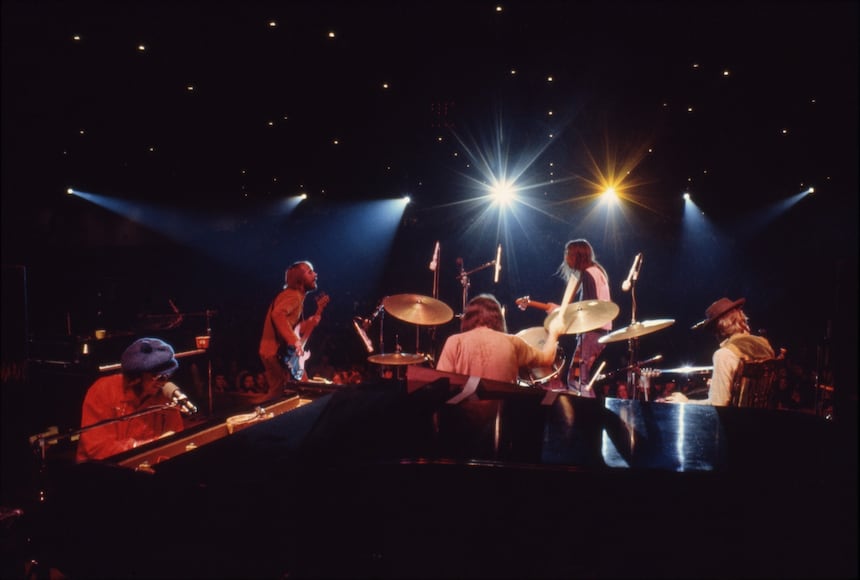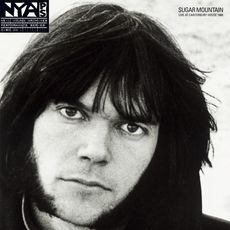The live arm of the many-tentacled beast that is the Neil Young Archives (NYA) has grown into finally came into being in 2006 with the release of Volume 02: Live at the Fillmore East under the Performance Series banner (the catalog was segmented into multiple categories and titles haven’t always been released in numeric volume order). More live material followed with 2009’s Archives Vol. I 1963-1972 and 2021’s Vol. II, and three more multi-album sets containing live material are in the planning stages. Young’s previously released studio albums are re-released as the Official Release Series, the Digital Masterpiece Series was the name given to albums like On the Beach when released on CD for the first time, and Special Release Series is reserved for previously unreleased studio albums, like 2020’s Homegrown. And finally, there is the Official Bootleg Series, the as-yet-to-launch concept where commonly bootlegged shows will see an official release. The biggest Archives draw so far for longtime fans and collectors are the Performance Series titles, which when combined with Young’s already released “official” live albums on Reprise, makes for a somewhat bewildering cacophony of solo live material currently on the market that cries out for the following primer.
Cherished mostly for the roar of Crazy Horse and/or Young's between song patter, all live Neil Young comes in two iterations: the acoustic and solo Neil who is concentrating particularly on his vocals and engages in playful between song flirtations with the audience; and the meant-to-be-played-loud Neil, with jagged, distorted, buzzy, Crazy Horse rock sets. Without exception all of the Archives material released so far (and I suspect forever) has been clear, highly detailed, and astonishingly rich and full. Even taking into consideration the age of the source material, none of these live recordings sound less than stellar. It's also a laugh worth mentioning given the virulent hostility that now aging established artists like Young, Dylan and Springsteen once held for bootleggers and releasing live shows—"It doesn't accurately represent me!" they all howled in faux indignation—and highly ironic to say the least they've all now decided to follow Frank Zappa's Beat the Boots lead and have gone into the bootleg business for themselves.

The Neil Young Archives (NYA) first numbered Performance Series title (but third to be released, in 2008) comes from the tender time when Young was learning to be a solo performer away from Buffalo Springfield and Crosby, Stills, Nash & Young. Sugar Mountain-Live at Canterbury House 1968 (Volume 00) a compilation of two gigs he played in November 1968 at the Episocal Church on the University of Michigan campus, has tentative but very appealing performances of lesser known tunes like "The Last Trip To Tulsa," and "Birds" (which later appeared on After the Goldrush) along with "Sugar Mountain" one of Young's most recorded numbers. Listed as separate tracks, numerous "raps" break up the tunes. The "Bookstore Rap" is a hilarious discussion of him taking "diet pills" as an employee of a Toronto bookstore. A later digression into what it means to write a song in the "Songs Rap" is illuminating but his halting attempts at playing classical guitar in "Classical Gas Rap," fail to move the crowd. The cover photo here is by Linda Eastman, soon to be Mrs. Paul McCartney.
Long famed for being part of the last tour with original Crazy Horse guitarist Danny Whitten, Live at the Fillmore East 1970 (Volume 02, released in 2006), is the other side of Young's musical persona. The set opens with a forceful performance of "Everybody Knows This is Nowhere," and a performance of Whitten's "Come on Baby Let's Go Downtown," later on highlight's Crazy Horse's early mix of singers. The craggy, countrified version of "Wonderin'" is superior to the recycled version that appeared on Young's much-derided 1983 throwback LP Everybody's Rockin'. The primary interest here is the ongoing conversation, the intertwining lines and the thrust and parry between the guitars of Whitten and Young. It was one of the most meaningful relationships in Young's career and the musical dialogue in this performance (which opened with Miles Davis and an electric sextet) is primal evidence of why Whitten's overdose death after being fired prior to the 1972 Harvest tour was a ghost that took years for Young to shake. One of the most essential releases in the Performance Series, this set which also appeared on Archives Vol. I, 1963-1972, is also a prime example of the wonders of the upgraded 96 kHz/24-bit resolution prevalent on much of the NYA.
Neil Young - Ohio [Live At Massey Hall 1971] (Video)
neilyoungchannelAlso from 1970 (released as Performance Series Volume 02.5 in 2013) comes the solo compilation Live at The Cellar Door, drawn from six shows in Washington, D.C. and featuring tunes from Everybody Knows This is Nowhere through Harvest, as well as two Buffalo Springfield tunes, "Expecting to Fly" and "Flying on the Ground is Wrong." Young is intense and deadly serious throughout, with almost no between-song patter left in. Moving from guitar to piano and back, he gives perhaps the best recorded solo performances in his entire live oeuvre, which includes outstanding versions of "Old Man," and the only recording released (so far) of "Cinnamon Girl" on piano.
Live at Massey Hall 1971, Volume 03—also included in the Archives, Vol. I box set, preserves Young's solo show in his hometown in absolutely stunning audio quality given the age of the tapes. Originally meant to be a live album follow-up to After the Goldrush, the 17-song show has become famous for being a set where Young tested out the Harvest repertoire in front of a crowd that reacted, as is usually the case upon hearing new material, with only slight applause. This version of "The Needle and the Damage Done," can also be heard as part of Harvest. "Dance, Dance, Dance" a track from Crazy Horse's self-titled debut eventually, retooled with new lyrics, became the Linda Ronstadt hit, "Love is a Rose." Another touch that speaks to how new this material was at that time is the experimental combination of Young's much-criticized, possibly misogynistic, "A Man Needs a Maid" (with lyrical tweaks from the version later heard on Harvest) and "Heart of Gold." Young is in incredibly strong voice throughout this tour de force performance. Three days after the Massey Hall show, Young repeated most of the set in Stratford, CT. in a show heard on the March 2021 NYA release, Young Shakespeare (Volume 3.5).
Young's run of live albums released on Reprise began in 1973 with Time Fades Away, which has a twisted emotional and recording history. Eventually allowed to go out of print by Young, who has repeatedly disparaged the album since its release, this was recorded following the Harvest tour and Danny Whitten's death (for which Young blamed himself). Add to that the band's money and personality issues and a setlist that was full of new material instead of the expected Harvest repertoire and the problems easily surfaced. There's a distinctly deflated emotional tenor to the whole affair—a mood now savored by some fans—that can be heard in Young's defiantly pleading performances of "Journey Through the Past," "Don't Be Denied," and "The Bridge."
In the years following Harvest, thanks to albums like American Stars 'N Bars and Comes a Time, Young became a full-blown rock star and rising confidence is what can be heard on his next major label live album, 1979's Live Rust, the follow-up to the live studio album, Rust Never Sleeps (where the live tracks received overdubs in the studio). This is the arena rock version of Young and Crazy Horse; hits mix with waves of audience mayhem from the start. Building from mostly acoustic versions of "Comes a Time," "After the Gold Rush" and "My My, Hey Hey (Out of the Blue)" (a tune which influenced every indie rock band on the planet susceptible to Young-itis), the album eventually goes loud and electric, pounding through a tight, rocked up, murderers’ row of "Powderfinger," "Cortez the Killer," "Cinnamon Girl," and "Like a Hurricane." The intro to "The Needle and the Damage Done" which initially confounded listeners when the album was first released is actually from the 1969 Woodstock Festival.
Released in February 2021, Way Down in the Rust Bucket (Performance Series Volume 11.5) is a typically snappy 1990 buzzrock set with Crazy Horse at The Catalyst club in Santa Cruz, CA, that includes "Surfer Joe and Moe the Sleaze" from Re-ac-tor and the first live performance ever of "Danger Bird" from the Zuma album. A potent one-two punch of "Mansion on the Hill" and "Like a Hurricane" with keyboard effects added is a reassuring lead-in to the set's final two tracks.
Neil Young - Mansion on the Hill - Way Down in the Rust Bucket (Official Music Video)
neilyoungchannelRounding out the very best of Young's live recordings is the volume-for-volume's sake vibe on 1991's Weld recorded on the tour to promote the studio album, Ragged Glory. Often tagged as his finest distortion-filled Crazy Horse set Weld repeats many of the hits from Live Rust but adds "Mansion on the Hill" and "Love and Only Love" among others from Ragged Glory as well as a version of Bob Dylan's "Blowin' in the Wind" and the definitive, knock-down-the-walls, riff rock version of "Hey Hey, My My (Into the Black)." It's no surprise that Young has stated many times that the making and mixing of this album permanently damaged his hearing.
Two Young live projects, both more theatrical stage shows than just pure music experiences, also deserve special mention. Volume 16 Return to Greendale, what’s billed as « a multi-faceted live concert experience » documenting a live performance of his 2003 studio album Greendale, was released in November 2020. Based on a murky narrative about environmentalism and human corruption with characters like Grandma, Jed and Sun Green, the live performance actually shows the music—despite the confusing spoken word parts—is actually a listenable addition to the Young canon. The same can be said for Earth, Young’s 2016 compilation of performances with Willie Nelson’s sons Lukas and Micah that was later sweetened in the studio with a nearly overwhelming layer of animal noises and nature sounds. Not to everyone’s taste, it is the latest statement among a lifetime of live albums that warts and all have fearlessly filled in the picture of Young’s inimitable career.










